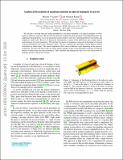Files in this item
Analytical description of quantum emission in optical analogs to gravity
Item metadata
| dc.contributor.author | Jacquet, Maxime Jules Roland | |
| dc.contributor.author | Koenig, Friedrich Ernst Wilhelm | |
| dc.date.accessioned | 2020-07-28T15:30:01Z | |
| dc.date.available | 2020-07-28T15:30:01Z | |
| dc.date.issued | 2020-07-27 | |
| dc.identifier.citation | Jacquet , M J R & Koenig , F E W 2020 , ' Analytical description of quantum emission in optical analogs to gravity ' , Physical Review. A, Atomic, molecular, and optical physics , vol. 102 , no. 1 , 013725 . https://doi.org/10.1103/PhysRevA.102.013725 | en |
| dc.identifier.issn | 1050-2947 | |
| dc.identifier.other | PURE: 269100575 | |
| dc.identifier.other | PURE UUID: a53731e0-8336-409b-8e7e-83aa0f0b743f | |
| dc.identifier.other | WOS: 000552991900005 | |
| dc.identifier.other | Scopus: 85089264839 | |
| dc.identifier.uri | https://hdl.handle.net/10023/20352 | |
| dc.description | Funding: UK EPSRC via Grant No. EP/L505079/1 and the IMPP. | en |
| dc.description.abstract | We consider a moving refractive index perturbation in an optical medium as an optical analogue to waves under the influence of gravity. We describe the dielectric medium by the Lagrangian of the Hopfield model. We supplement the field theory in curved spacetime for this model to solve the scattering problem for all modes and frequencies analytically. Because of dispersion, the kinematic scenario of the field modes may contain optical event horizons for some frequencies. We calculate the spectra of spontaneous emission in the frame co-moving with the perturbation and in the laboratory frame. We also calculate the spectrally-resolved photon number correlations in either frame. The emitted multimode field comes in different types depending on the presence of horizons. We show that these types are robust against changes in the system parameters and thus are genuine features of optical and non-optical analogues. These methods and findings pave the way to new observations of analogue gravity in dispersive systems. | |
| dc.format.extent | 16 | |
| dc.language.iso | eng | |
| dc.relation.ispartof | Physical Review. A, Atomic, molecular, and optical physics | en |
| dc.rights | Copyright © 2020 American Physical Society. This work has been made available online in accordance with publisher policies or with permission. Permission for further reuse of this content should be sought from the publisher or the rights holder. This is the author created accepted manuscript following peer review and may differ slightly from the final published version. The final published version of this work is available at https://doi.org/10.1103/PhysRevA.102.013725. | en |
| dc.subject | Analog gravity | en |
| dc.subject | Event horizon | en |
| dc.subject | Hawking radiation | en |
| dc.subject | Optical horizon | en |
| dc.subject | Optical analogue | en |
| dc.subject | Quantum optics | en |
| dc.subject | Quantum field theory | en |
| dc.subject | QB Astronomy | en |
| dc.subject | QC Physics | en |
| dc.subject | Atomic and Molecular Physics, and Optics | en |
| dc.subject | DAS | en |
| dc.subject.lcc | QB | en |
| dc.subject.lcc | QC | en |
| dc.title | Analytical description of quantum emission in optical analogs to gravity | en |
| dc.type | Journal article | en |
| dc.description.version | Postprint | en |
| dc.contributor.institution | University of St Andrews. School of Physics and Astronomy | en |
| dc.identifier.doi | https://doi.org/10.1103/PhysRevA.102.013725 | |
| dc.description.status | Peer reviewed | en |
This item appears in the following Collection(s)
Items in the St Andrews Research Repository are protected by copyright, with all rights reserved, unless otherwise indicated.

